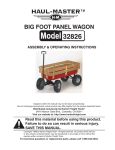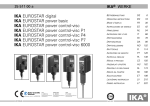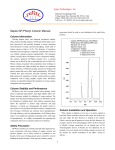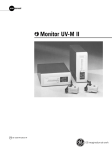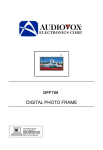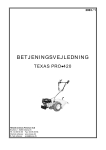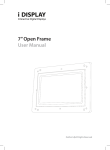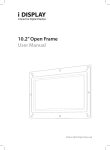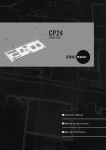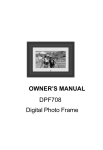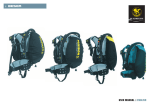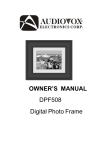Download none LS Instructions / Assembly
Transcript
NORTHSTAR TRAILERS Assembly Guide for LOADSTAR Trailer Congratulations! You are the proud owner of a NORTHSTAR trailer. Please follow the instructions and steps in this manual for proper assembly. You may also watch our assembly video on You Tube by typing in Northstar Trailer assembly. TRAILER PARTS LIST Part Part Description No. 1 Frame (deck) 2 Tongue (with wiring harness) and Coupler (hitch) 3 Top Rail 4 Front Corner Support 5 Rear Corner Bracket 6 Rail Support 7 Wheel and Hub Assembly 8 Leaf-Spring 9 Axle 10 Fender 11 Wiring Harness 12 Rear Gate Qty. 1 1 1 2 2 7 2 2 1 2 1 1 HARDWARE Part No. A B C D E F G H I J K L M N O P Q R Description U-Bolt Spring Plates Small Locknut 3 ½” threaded Pin-Bolt 3 5/8” threaded Pin-Bolts Rear Gate-Pin Large Nut Small Lock-Washer Small Flat-Washer Small Bolts 1” Cotter-Pin Spare Tire Lug Nut Taillight/Brake Light Running Light Taillight/Brake Light L-Bracket License Plate Bracket Small Brass Screw (included in bag with blue wire connectors) Wire Connector Qty. 4 2 21 4 2 2 6 21 32 32 8 2 2 2 2 1 4 8 Make sure that all parts, as listed above, are included in your shipment. If any parts are missing please contact NORTHSTAR at 1-855-375-3088. Other tools needed for assembly: grease gun, flathead screwdriver, socket set, wrench set, small zip-ties, small rubber mallet. IMAGES OF PARTS AND HARDWARE INVERTED ASSEMBLY This trailer requires inverted assembly. (Assembled upside-down). Start by turning the trailer frame upside-down so the trailer deck is facing the ground. Use a table robust enough to support the weight of the trailer frame and high enough to elevate the frame to waist-height, or place the corners of the frame on buckets, or use sawhorses to elevate each end. CAUTION: This trailer is heavy. More than one person is required to flip the trailer frame and assembly this trailer. Personal injury may occur if you try to assemble this trailer alone. STEP 1: LEAF SPRING & AXLE ASSEMBLY a. Flip the trailer frame (1) upside-down, and place the frame on a waist-high table or other elevated supports in order to facilitate assembly. b. Position the leaf-spring (8) on the frame’s spring casing (welded to the frame) so the eye in the leaf-spring is positioned toward the front of the trailer and aligns with the bolt eyehole in the spring casing. c. Fasten the leaf-spring to the casing with 3 ½” pin-bolt (D) and a large nut (G) by inserting the bolt through the leaf-spring and through the eyeholes in the casing. (Leave tension loose to allow play when aligning the axel; you will securely tighten bolts in step “i”.) d. Secure the hooked end of the leaf-spring to the casing by running a 3 ½” pinbolt (D) through the eyeholes of the leaf-spring casing and over the flat side of the leaf-spring. Fasten the bolt with a large nut (G). e. Lay the axel (9) on top of the leaf-springs, and align the holes in the axel knobs with the posts on the leaf-springs. The axle will lie snug on top of the springs. FASTEN AXLE TO LEAF SPRINGS f. Take two U-bolts (A) and slide them over the axle, so the bolts hang over the axle and on both sides of the leaf-springs. Attach the spring-plate (B) to the U-bolts using the small locknuts (C), and then tighten the locknuts to fingertightness. g. Once all of the locknuts are on the U-bolts, tighten the locknuts in alternating sequence in order to ensure an even, level plate pressure. h. Continue to tighten the locknuts until the spring-plate just begins to bend and conform to the shape of the leaf-spring. (Approximately 35 ft-lbs of torque). i. Securely tighten the bolts from step “c” and “d”. After tightening the bolts, insert a cotter-pin (K), then secure the cotter-pin by bending at least one leg to 90 degrees. Tip: It is easier to run the trailer’s wire before installing the wheels. You will install the wheels in STEP 3. STEP 2: WIRE ASSEMBLY Note: when standing at the back of the trailer looking toward the front, with the trailer still inverted, the wiring harness bundle with the YELLOW wire will be threaded along the DRIVER’S side (right side when looking at the trailer upside-down) to the brake/signal light, and the bundle with the GREEN wire will be threaded along the PASSENGER’S side (left side) to the brake/signal light. RUN WIRE a. Locate the first rib back from the front of the trailer. (The only rib that has an entry hole and flat bracket). While facing the front of the trailer, push the wiring harness (11) through the eye in the rib, and run the harness with the yellow wire inside the rib to your right, and the harness with the green wire to your left. b. Insert the hollow, round plug into the eye of the rib plate bracket. (This prevents the wires from rubbing directly against the frame). Leave the plug exposed. (The plug will connect to tongue’s wire in STEP 5). c. Pull the wires along the ribs until the wires reach the side of the trailer. d. Where the wire bundles split, run the green and yellow bundles along their respective sides of the trailer, along the frame, and back to the tail/brake light positions, and then run the brown and white wires to the running light position on each corner of the trailer. Pull the wires through the holes on the sides of the trailer in preparation for light connection. STEP 3: ATTACH WHEELS TO AXLE Note: the hub assembly comes attached to the wheels with pre-lubricated bearings and washers. Upon removing the dust-caps take special care to not drop the bearings or get them dirty. a. Carefully remove the dust-cap from the wheel (7) by gently prying around the edges of the cap with a small, flathead screwdriver, or by using a long bolt to gently drive through the backside of the hub and into the cap. b. Remove the outer bearing, flat-washer and tabbed-washer from the interior of the hub, and then set aside. c. Carefully slide the wheel onto the end of the axle. d. Slide the bearings into the hub; press into place carefully as to not remove any grease. e. Place the flat-washer on the bearing, followed by the tabbed-washer. Ensure that the washers are snug with and pressed flat against the bearings. f. Fully tighten the castle-nut against the bearings to the point that the nut applies enough pressure against the bearings to lock them into place. Then, loosen the castle nut approximately ¼”, or to the point where the wheel can spin; the nut should be loose enough that the wheel freely spins, yet tight enough that the wheel does not have horizontal play or wiggle. The final castle-nut tension will be approximately 35 ft-lbs. (Proper tension is critical to the longevity of the bearings). g. Align a slot of the castle-nut with the tabbed-washer so the washer tabs appear in the slots of the nut, then use a screwdriver to bend one of the washer tabs into a notch of the nut. This is very important to ensure the integrity of the hub assembly. h. Attach a grease gun to the hub’s Zirk fitting—located on each end of the axle—, and apply pressure until you can see grease extruding from the bearing casing. i. Replace the dust-cap by tapping it into place with a rubber mallet. RTV sealant or silicon may be applied to the circumference of the dust-cap before installation to ensure that the cap will not fall off while in tow. Let the sealant completely dry before towing. Note: the dust-cap has an exterior Zirk fitting access, and does not need to be removed to grease the bearing. Grease the wheel bearings a minimum of 1x per year for normal use, and up to 3x per year for frequent use in order to ensure the longevity of the bearings. Adjust and re-grease the bearings after the first 100 miles. STEP 4: ATTACH TONGUE TO FRAME Remember: the trailer is still upside-down, so all components must be installed upsidedown. a. *Make sure that the tongue’s wiring harness extends through both the backside and the front of the tongue. b. Align the tongue’s (2) eyeholes with the eyeholes on the frame. c. Use the 3 5/8” threaded pin-bolts (E) and large nuts (G) to fasten the tongue to the frame. Note: Be careful not to pinch or cut the tongue’s wiring harness when inserting the bolts. d. Tighten the 3 5/8” bolts from step “c” as tight as a manual wrench will allow, insert cotter-pins, and secure the cotter-pins by bending at least one leg to 90 degrees. e. Securely tighten the bolts that connect the trailer’s coupler/hitch to the tongue. (These bolts are loose. You must tighten them). *Note: In rare cases the tongue’s wiring harness may fall inside the tongue after shipping and unpacking, and you may need to fish the wires and pull them out of the tongue. TIGHTEN AND SECURE ALL BOLTS! After the tongue is installed in its proper position, make sure to securely tighten all bolts, and make sure that all cotter-pins are installed, and that at least one leg of each cotter-pin is bent to 90 degrees. STEP 5: FINAL WIRING ADJUSTMENT a. Ensure that the tow-vehicle connector (trailer plug) and wires that extend from the hitch have sufficient slack to connect to the vehicle’s receptor plug. b. Plug together the tongue’s wiring harness with the trailer frame’s wiring harness. c. Tuck any excess wire and the main wiring connector into the base of the tongue. ROTATE THE TRAILER TO AN UPRIGHT POSITION. Position the trailer so the tires are on the ground. More than one person is required to rotate the trailer; DO NOT ATTEMPT TO ROTATE THE TRAILER TO THIS POSTION ALONE. STEP 6: ASSEMBLE AND INSTALL LIGHTS INSTALL TAIL/BRAKE LIGHTS a. Fasten the taillight/brake light L-brackets (O) to the frame using two, 1” bolts (J), one small flat-washer (I) and one small lock-washer (H) for each bolt. b. Remove the nuts from the back of the taillight (M). c. Determine the length of the wires needed to connect the wiring harness with the light, then twist the wires together to shorten the wire slack. d. Place the loop from the harness’s white ground wire over the closest stud on the back of the light. e. Connect the taillight wires with like colors from the wiring harness. f. Slide the studs on the back of the taillight (M) through the L-bracket. g. Slide the license plate bracket (P) onto the taillight studs. h. Use the nuts from the back of the taillight to fasten the light to the bracket. i. Shove any excess wire back into the eyehole of the frame. j. Tie off any wiring slack with a small zip-tie. Note: follow the same sequence for the passenger-side taillight, but without the license plate bracket. INSTALL RUNNING LIGHTS a. The white wire from the harness is not needed for ground on this light and can be capped off (with wiring connector (R)) or tied to other wires in the harness with a small zip-tie. b. Connect the brown wire from the running light (N) with the brown wire from the wiring harness by pushing the wires together. c. Position the brown wire under the silver tab, between the tab and the lens. Run the screw through the silver tab, and then fasten the light to the trailer using two small brass screws (Q) found in the small bag with the wire connectors. Tip: Once the lights are installed, pull any excess wire back into the frame. STEP 7: ATTACH FENDERS a. Align the fender bolt-holes with the bolt-holes in the frame. b. Use 1” bolts (J), flat-washers (I) and lock-washers (H) to fasten the fender (10) to the frame STEP 8: INSTALL SIDE RAILS & CORNER BRACKETS Note: fasten bolts to finger-tightness until the side braces, brackets and side-rails are all in place—this will allow you to make alignment adjustments if needed. Once all parts are aligned and secured, securely tighten all bolts. INSTALL REAR CORNER BRACKETS, RAIL SUPPORTS AND RAIL a. Attach the rear corner brackets (5) and front corner brackets (4) to the frame using 1” bolts (J), small flat-washers (I), small lock-washers (H) and small locknuts (C). b. Install the rail-supports (6) to the trailer frame using 1” bolts (J), small lockwashers (H) and small flat-washers (I). Do not fully tighten yet. c. With the help of another person, fasten the main top-rail (3) to the top of the supports using 1” bolts (J) and small locknuts (C). d. The last rail-support will fasten to the rear corner brackets. Note: the rail supports fasten to the outside of the rails. Install the bolts from the trailer-side of the rail, through the rail and into the rail support. TIGHTEN AND SECURE ALL BOLTS! After all the rails and supports are in their proper positions, make sure to tighten all bolts. STEP 9: INSTALL REAR GATE a. Connect the gate’s pin-slots with those on the trailer using the gate-pins (F). b. Secure the gate-pins with the cotter-pins, and then secure the cotter-pins by bending at least one leg to 90 degrees. YOU ARE FINISHED! We hope that you enjoy your NORTHSTAR TRAILER. Please contact us at 1-855-375-3088 or email [email protected] if you have any questions. Our business hours are Monday-Friday 9:00 a.m. to 5:00 p.m. MST. TRAILER SPECIFICATIONS Trailer Weight: 440 lb.s GVWR: 2000 lbs Cargo Weight: 1560 lbs Length (w/ tongue): 148” Width: 60” Tire Size: 13x175 Note: The dealer that sold you this trailer will ship you the trailer’s Certificate of Origin. The certificate will arrive approximately two weeks after the trailer is delivered.













